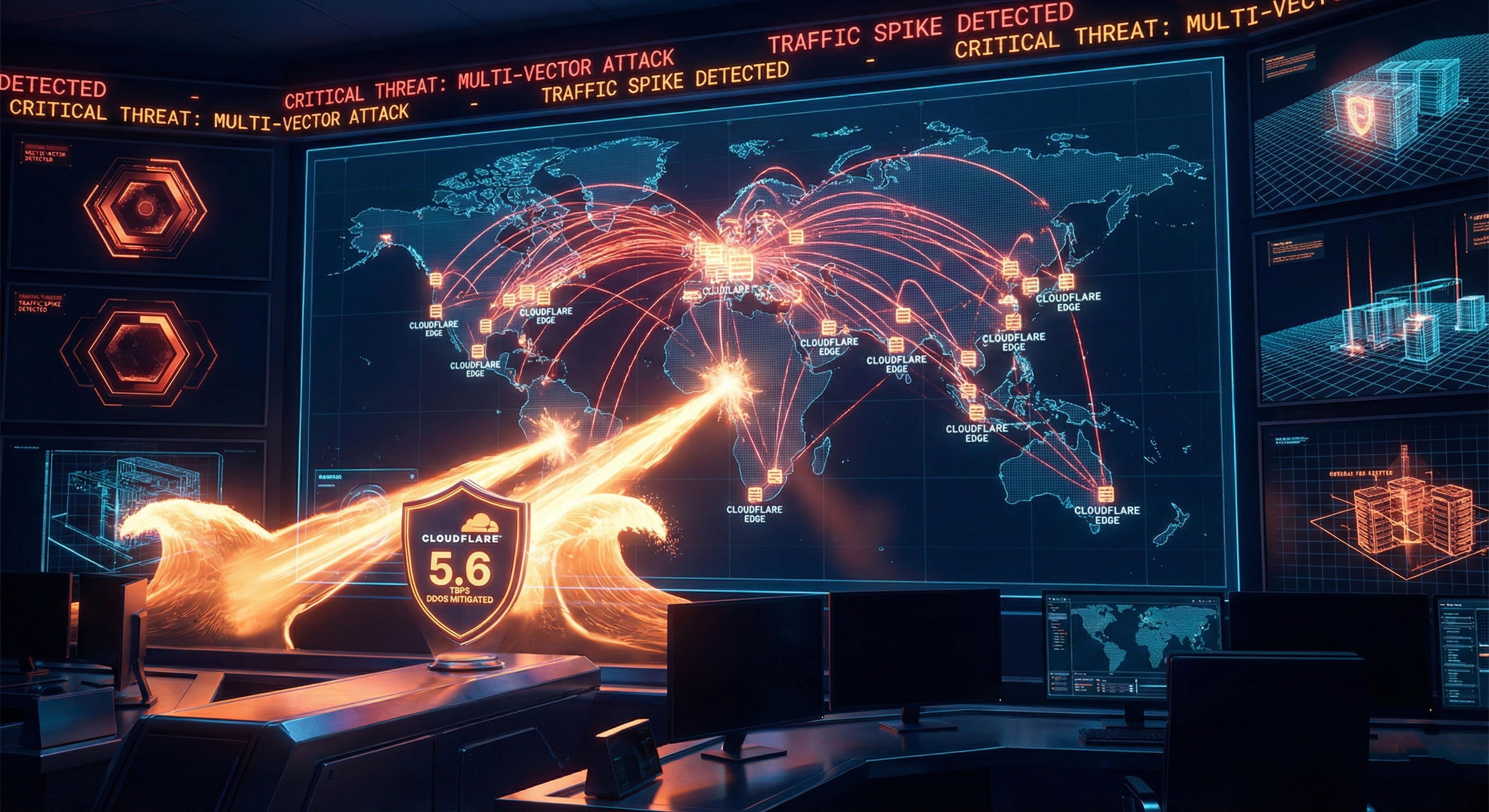Record-Breaking DDoS Cyberattack on Cloudflare: What Happened and Why It Matters
Introduction
In a major escalation of cyber-threat activity, Cloudflare — one of the world’s leading web security and performance providers — has revealed that it was hit by a record-breaking Distributed Denial-of-Service (DDoS) attack, with traffic surging to unprecedented levels. This attack highlights a dangerous shift in cybercriminal capabilities and raises serious concerns for organizations relying on cloud infrastructure and web services.
The Attack: A New Global Record
Cloudflare confirmed that the attack peaked at 5.6 Tbps, making it the largest DDoS attack ever recorded. This level of traffic is enough to overwhelm even the most advanced networks and marks a significant milestone in the evolution of botnet-powered cyberattacks.
The assault involved:
- Hundreds of thousands of compromised devices
- High-bandwidth cloud servers hijacked by attackers
- Massive Layer 3 and Layer 4 traffic floods
- Multi-vector attack patterns designed to bypass defenses
Unlike previous attacks that relied primarily on weak IoT devices, this assault leveraged hijacked virtual machines and high-performance servers, giving the botnet unprecedented power and speed.
How Cloudflare Responded
Despite the unprecedented size of the attack, Cloudflare’s automated mitigation systems were able to detect, absorb, and neutralize the malicious traffic without causing downtime for customers.
Cloudflare used multiple strategies to withstand the attack:
- Real-time traffic filtering to identify and block malicious requests
- Global Anycast network routing to distribute traffic across multiple data centers
- Adaptive DDoS mitigation powered by machine learning to dynamically adjust defenses
- Network capacity scaling across Cloudflare’s vast infrastructure
With a network handling trillions of requests daily, Cloudflare was able to distribute the attack load, ensuring uninterrupted service for clients worldwide.
Why This Attack Is a Warning for the Future
1. Botnets Are Getting Stronger
Cybercriminals are shifting from exploiting low-power IoT devices to cloud-based servers, giving them exponentially more computational power and bandwidth.
2. Attacks Are Becoming Multi-Vector
Modern DDoS attacks are rarely a single type of traffic. Attackers increasingly combine:
- UDP floods
- SYN floods
- DNS amplification
- HTTPS request floods
This multi-pronged approach complicates mitigation and increases the chances of overwhelming defenses.
3. Cloud Providers Are Now Prime Targets
Instead of attacking small or individual websites, threat actors are targeting infrastructure giants like Cloudflare. Disrupting such services can have cascading effects across the internet.
4. DDoS as a Service Is Growing
Access to massive botnets is increasingly affordable and automated. DDoS-as-a-Service offerings enable even low-skilled attackers to launch devastating campaigns.
Impact on Businesses and Internet Users
While Cloudflare successfully mitigated the attack, the incident has far-reaching implications:
- Organizations relying on cloud services must re-evaluate DDoS resilience.
- Smaller businesses lacking robust protection remain vulnerable to downtime.
- Critical sectors such as finance, healthcare, and government could face serious disruptions if similar attacks succeed.
- Attackers may use massive DDoS storms as distraction techniques while carrying out data breaches or ransomware attacks.
Preventive Measures for Organizations
To defend against large-scale attacks, businesses should adopt a multi-layered approach:
- Implement DDoS protection services such as Cloudflare, Akamai, or AWS Shield
- Use rate-limiting, Web Application Firewall (WAF) rules, and traffic filtering to block abnormal traffic
- Ensure redundant hosting and multi-region architectures to distribute load
- Monitor network traffic for spikes to detect attacks early
- Patch and secure servers to prevent them from being hijacked into botnets
Conclusion
The record-breaking DDoS attack on Cloudflare marks a turning point in cyber warfare. At 5.6 Tbps, it demonstrates the unprecedented power of modern botnets and underscores the critical importance of scalable, intelligent cyber defenses for organizations of all sizes.
